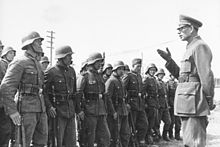On the evening of June 3, I sat in a packed auditorium at New York’s Center for Jewish History, to see “Return to a Burning House,” a new Slovak documentary film on the martyred heroine, Haviva Reick, after whom the kibbutz seminar center, Givat Haviva, was named. (Givat Haviva also houses the museum and archives of the radical Zionist youth movement, Hashomer Hatzair, of which Reick was a member.)
Haviva Reick’s life story is dramatic and compelling. It’s obviously a close parallel to that of Hannah Senesh, the more famous Israeli who died in Hungary on a similar mission, to facilitate the rescue of Jews threatened with annihilation under a Nazi-allied regime; indeed, the two women parachuted into enemy-occupied countries as part of the same general operation.
The film itself was not great from a production standpoint, perhaps because the visual materials available to the filmmaker(s) were very limited. This story cries out for a major production as a feature film, and I hope this happens one day.
The program included some introductory remarks from Ido Aharoni, the Israeli Consul General in New York (who spoke very eloquently) and Jana Trnovcova, the Consul General of Slovakia. It concluded with a panel discussion and questions from the audience. The panelists were Mirka Monar Lachka, the film’s Slovakian producer, Thomas Ort, an assistant professor of modern European history at Queens College/CUNY, and Dr. Rochelle G. Saidel — the author of The Jewish Women of Ravensbruck Concentration Camp and co-editor of Sexual Violence Against Jewish Women During the Holocaust (among other works) — and the founder and director of the Remember the Women Institute.
Prof. Ort indicated that his grandfather was a Slovakian Jew who married his Catholic grandmother, and by converting to Catholicism avoided deportation for most of World War II. He stated that because Josef Tiso, head of state of the Nazi-allied Slovak puppet regime, was a Roman Catholic priest, he safeguarded converts from the Nazis; I hasten to add, however, that Tiso was an antisemite who cooperated on and off with the genocide, depending upon the pressures he experienced at the moment. This immunity for converts ended with the Slovak national uprising against the Nazis, which lasted for about two months after its onset on August 29, 1944.
It was a serious effort to oust the Tiso regime and its Nazi allies, including the setting up of a rebel government and involving masses of Slovak rebel soldiers and even a tiny rebel air force. Like the Warsaw uprising in the summer of 1944, it suffered from Stalin’s lack of support, who refused adequate aid to the rebels and forbade Communist partisan fighters to coordinate their efforts with the rebels.
Haviva Reick’s small group of four or five parachutists from Israel aided in the rescue of downed American and British air force fliers, but refused to get out with them in time. She fled the Nazi onslaught by seeking refuge in the mountains, but was captured with a couple of hundred fleeing Jews and others, by Russians who they had mistakenly thought were Soviet soldiers. They were, in fact, Vlasovites — soldiers of the “Russian Liberation Army” — mostly ex-Red Army soldiers recruited from German prisoner-of-war camps by General Andrey Vlasov to fight against Stalin’s regime.

Vlasov with his ‘Russian Liberation Army’
Vlasov was a highly accomplished Soviet general who was captured by the Germans while attempting to relieve Leningrad; he renounced Stalin and after a long political struggle with parts of the Nazi leadership, succeeded in putting together a small army. When the film details how Reick and her group had greeted the “wrong Russians,” a column of Soviet soldiers are depicted on the march; but as indicated in the accompanying photograph, the film misses the small nuance that those Russians were wearing German uniforms.
The film is unclear whether the resulting massacre of Reick and others in her party was committed by the Vlasovites, Slovakian fascists or Nazi SS. My guess is the SS (but this is only a guess).
During the closing days of WW II, the Vlasovites turned their guns against the Nazis and helped Czech forces liberate Prague. They then marched west and surrendered to the Western Allies. Within the following year, they were forcibly deported to the Soviet Union, where they undoubtedly met a bitter fate.
The film frankly reveals that Slovakia today is still home to both antisemites and ethnic Slovaks who are not. According to Ms. Trnovcova (the Consul General), many or most Slovaks honor Haviva Reick as a Slovak hero, including at a memorial set up in her hometown, depicted in the film. But the film also shows an antisemitic politician who was overwhelmingly elected mayor of this town (reportedly as an anti-corruption candidate), giving vent to his hatred of “foreigners.”
It also features some scenes of the campus at the Givat Haviva Institute in Israel, including remarks delivered by Yaniv Sagee, currently Givat Haviva’s executive director. He used to serve as a shaliach (representative) for Givat Haviva and Hashomer Hatzair while being based in New York.



Leave A Comment